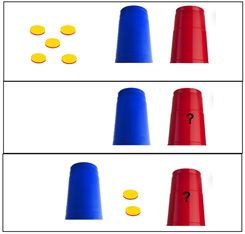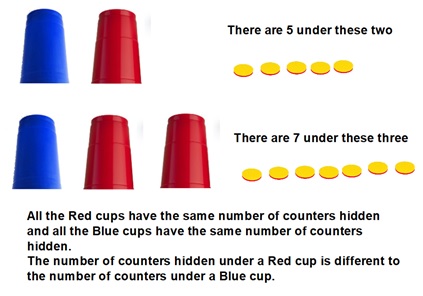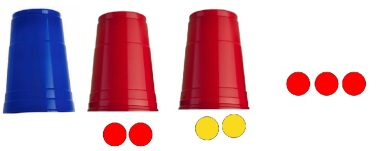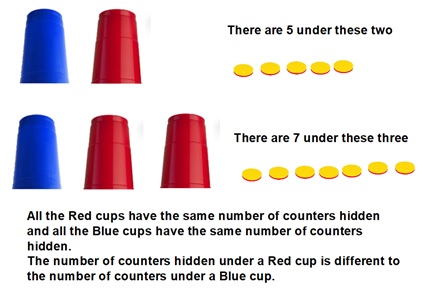I spoke at MathsConf14 about how simultaneous equations are not as difficult as we make them out. In fact, if we teach them with manipulatives and pictures they are child’s play. This made me wonder about how young a child’s play is it? If we can get very young children to deduce the value of 2 or more unknowns then couldn’t we use these same methods with much older pupils to help them get it?
In the past, I have succeeded in getting pupils at the end of Reception solving pictorial simultaneous equations by deduction (not trial and improvement) and Year 1 pupils solving simultaneous equations with cups by deduction. I wondered at how young an age might it be possible to get pupils to solve the cups version by deduction.
Because this involves working with pupils in the first term of Reception, it has to be done as fun and magic with the magic cups and the magic counters, and each session is just a few minutes with tiny steps taken in each one. Pupils are invited to play with me but always have the option not to or to opt out as soon as they don’t want any more. It is usually the case when I play a game with Nursery and Reception pupils that I stop a game before they want to.
Checking the prerequisites
My initial interactions were to check that key prerequisites were in place before moving onto the games:
- Number names (they know the number names in the right order)
- Rational counting (they count objects giving each one the correct number name)
- Cardinality (they know that the last name in the count represents the quantity)
- Conservation (once they have counted or subitize 5, the quantity remains 5)
- Subitizing to 5 (they can tell by looking how many without rational counting)
- Well-developed part-part-whole concept
- Number bonds for 5 (they know the pairs of numbers that together make 5)
- Hierarchical inclusion (they know that in 5 objects we can find 5,4,3,2,1, and 0 but not 6)
Because we build the development of these into our Nursery activities, environment and play, the pupils I am working with already have all of these in place at the start of Reception.
Game 1
‘When you close your eyes, I will hide the 5 counters under the Blue cup and the Red Cup. There will be a different number of counters under the cups because they are different colours. Close your eyes’. I hide the counters. ‘Now open your eyes. Do you know how many of the 5 counters are under the Red cup? This means you really know how many there are under the Red cup, not just a guess’.

If they reply that they do know, for example they say they know there are 4, then we have a look to see. It takes some pupils a few goes getting it wrong to begin to understand the difference between ‘knowing’ and ‘thinking/guessing’. If they say a number more than 5 then we have to work at that as well. For some, their first answer is ‘No’ because they realise straight away that it is not possible to know how many there are.
When they say ‘No’ then we discuss what might be under the Red cup and the Blue cup – number bonds for 5, preferably given in a systematic list (this is an example of an equation with 2 unknowns so that we cannot give the solution, but because they are whole numbers, we can list the possible solutions). I then show them how many there are under the Blue cup and ask them if they now know how many there are under the Red cup (this has now become an equation with only 1 unknown and so we can solve it). If their number bonds for 5 are strong then the answer is pretty much instant; they also tend to model their answer with fingers because they are used to showing their answer like this. They are not counting on their fingers to work out the answer – the answer is coming from long term memory – it is their non-verbal way of communicating their response.
To Be Continued as we attempt to move towards trying to solve the following type of problem by deduction not trial and improvement or guess and check. This will involve tiny steps and we may well run into problems with ‘cause and effect’!

Friday 14th September 2018
I couldn’t find time to visit our EYFS block this week until today. My 4-year-old collaborators from last week were in a TGIF frame of mind today and understandably wanted to run around outside – who can blame them!!
I did, however, manage to recruit a couple of other Reception playmates and one of them was able to play/solve Game 1 and also managed Game 2 – this is where I expected to hit a stumbling block, but he got it. In fact, he went from never having done any of this to solving Games 1 and 2 in a matter of minutes!
I found out that I need to change the way I ask one of the questions because I failed to take into account the literal way in which they interpreted a question I asked them. Me:’Where did these 2 extra counters come from?’ Pupil: ‘From the bag’ (on the table).
Game 2
Attempt 1
Me: ‘Here are the Blue and Red cups and they have a total of 5 counters hidden under them. Do you know how many under the Red cup?’

Pupil: ‘No’
We discussed that he could not know because he could not see and could only have a guess from 0 to 5.
Me: ‘I will now bring in another Red cup and it has exactly the same number of counters hidden under it as this first Red cup, (adds an extra 2 counters to the original 5) and now there are 1,2,3,4,5,6,7 counters here. Do you know how many counters are hidden under this new Red cup?’

Pupil, after some thinking time: ‘No’
Attempt 2
I remove the extra 2 counters and the new Red cup.
Me: ‘I will now bring in another Red cup and it has exactly the same number of counters hidden under it as this first Red cup, (adds an extra 2 counters – yellow side up- to the original 5) and now there are an extra 2 counters here. Do you know how many counters are hidden under this new Red cup?’

Pupil, after some thinking time: ‘Two’
Me: (moving those 2 counters alongside the new Red cup) ‘So there are 2 counters under this Red cup. How many under this (original) Red cup?’

Pupil: (instantly) ‘Two’
Me: (moving 2 counters alongside the original Red cup) ‘So how many counters must be under this Blue cup?’

Pupil: (instantly) ‘Three’
I then reveal each cup in turn to show that he is correct.
Reflection:
I learnt from doing this with Year 1 pupils, in the past, that it is the ’cause and effect’ that is the issue here. I have to get them to realize that the cause of the extra 2 counters is the introduction of the second Red cup, and so they may then deduce that there must be 2 counters hidden under it. If, for example, you get them to close their eyes whilst you bring in the extra cup and counters and then ask them to open them, then they do not tend to make that link – they have to see it happening. The long-term aim is for them to compare the two situations, see what is the same and what is different and hence deduce the number of counters under the extra cup – this will enable them to deduce the counters under all the cups.
It was interesting to see the different responses to when I counted the new total of 7 and when I highlighted the extra 2.
This gives me hope that the aim may well be achievable. This pupil has managed most of the key steps in a matter of minutes and my target is the end of the autumn term, doing only about 5 minutes a week with them.
Friday 21st September 2018
Game 3

NB There is no movement when presented like this, just two static lines – a pair of equations with 2 unknowns and 2 given facts.
This was completed today by ‘Pupil 3’ today in a 5 minute session. I prompted with questions:
- How many in the Blue Cup and Red cup altogether? (Row 1) [5]
- How many in the Blue Cup and 2 Red Cups altogether? (Row 2) [counted 7]
- How many more in these cups than in these cups? (Compare Row 2 with Row 1) [2]
- How many in the Red Cup (Row 2)? [2: He moved 2 of the counters alongside the Red cup] How many in the other Red cup (Row 2)? [2: He moved 2 counters alongside the other Red cup]
- So how many in the Blue Cup (Row 2) [3: He moved the remaining 3 counters alongside the Blue cup]
- So how many in Blue Cup (Row 1)? [2 then corrected to 3]
- So how many in Red Cup (Row 1)? [2]
Whenever he gave me the correct number of counters hidden under a cup, we looked to see if he was correct – except for the one error when I asked him again.
Looking ahead
Another Pupil 4 is just behind this stage and I hope to complete this with him next week. I am hoping that Pupil 3 will do much of this with less prompting next week.
- Pupil 3 had 5 minutes last week and about 5 minutes today with no practice in between.
- Pupil 4 had about 3 minutes last week and about 5 minutes today with no practice in between.
- I have several others in the pipeline to get going with in the next week or so if I can find the time and also, hopefully, catch up with Pupils 1 and 2 again.
I may attempt to get parental permission to film these sessions (faces not shown) so that I can share this with you – much more powerful to witness rather than read about it.
13 November 2018
I have managed to find time at last to get back to this today. I now have 4 pupils solving these equations with cups and counters and 2 more pupils ‘working towards’.
An interesting point was raised on Twitter today and I would like to clarify my position. I am totally opposed to ‘too much too soon’ in EYFS and do not believe that Reception children should be doing simultaneous equations – I made this clear in my vlog with Craig Barton. What I do want to demonstrate is that if we use manipulatives and a visual approach to finding the value of unknowns then it makes it much easier than if we teach solely through procedures. As with much of my approach to teaching, I believe that if we introduce topics to older children with the CPA approach that we use with younger children then both teachers and pupils may find it less of a struggle than they currently might do. It is looking like the sort of deduction required to solve for two unknowns is literally child’s play for some (but not all) young children and I think that there are some lessons to be learnt for teaching with these ideas when working with much-older pupils.
